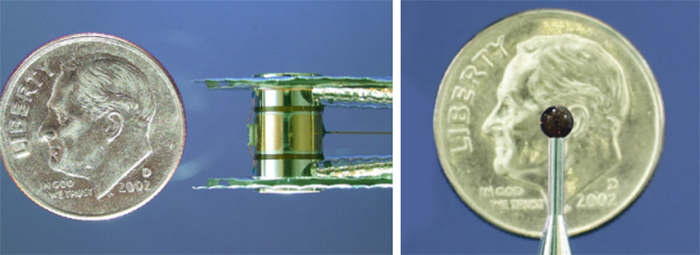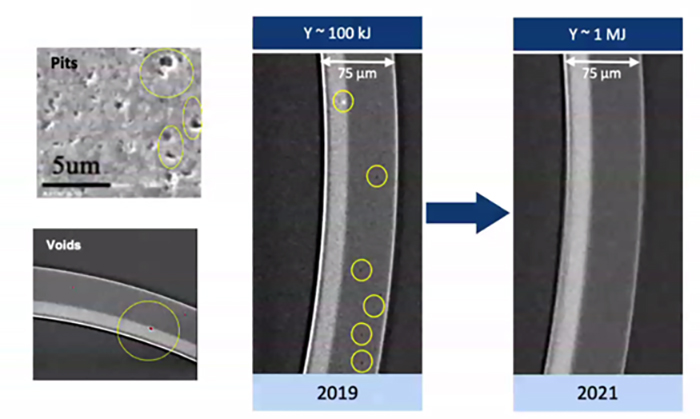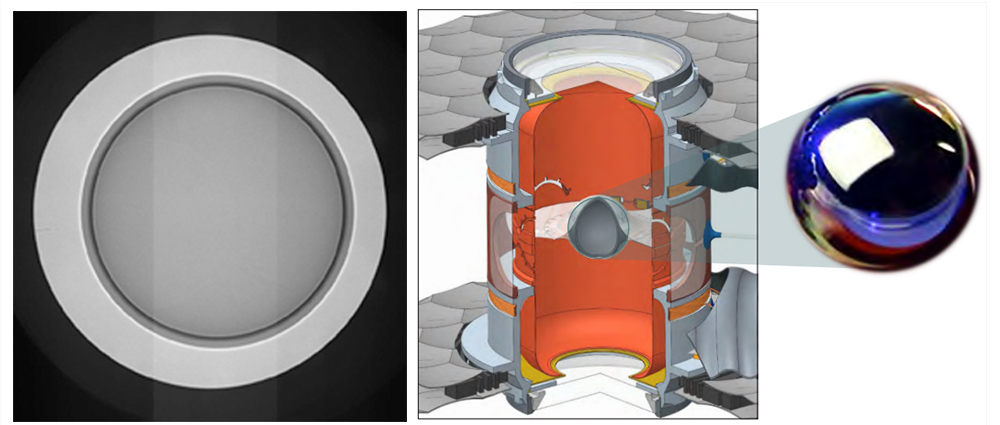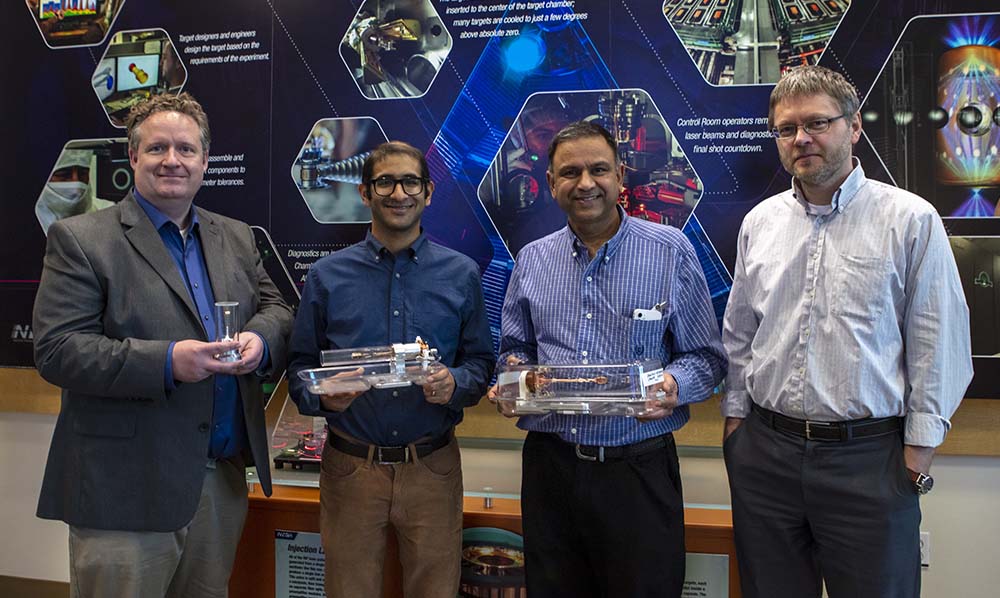Target Evolution Is a Key
to NIF’s Continued Success
April 26, 2023
Part 8 of “The Age of Ignition,” a NIF & Photon Science News Special Report describing the elements of Lawrence Livermore National Laboratory’s fusion breakthrough at the National Ignition Facility
The intricate, delicate targets used in NIF experiments are marvels of design, engineering, and precise manufacturing.

“We’ve been working over the last 16 years on continuously improving the quality of these targets,” said NIF Target Fabrication Program Manager Michael Stadermann. “That effort has been based on decades of prior target development activities at Livermore and elsewhere.”
And, he added, the bb-sized synthetic diamond fuel capsules at the heart of NIF’s targets are “almost perfectly round” with a surface 100 times smoother than a mirror.
But for NIF to continue to match and exceed December’s milestone ignition shot, an even higher level of perfection—or even a different capsule material—may be needed.
 NIF, the world’s largest and highest-energy laser system, focuses 192 laser beams into a centimeter-scale hohlraum (left) containing a millimeter-scale fusion capsule (right), which is then compressed by a factor of 30 to the width of a human hair (see “How NIF Targets Work”).
NIF, the world’s largest and highest-energy laser system, focuses 192 laser beams into a centimeter-scale hohlraum (left) containing a millimeter-scale fusion capsule (right), which is then compressed by a factor of 30 to the width of a human hair (see “How NIF Targets Work”). “Perfection is really hard, so we’ve yet to get there,” Stadermann acknowledged. “We still have tiny flaws on our (capsule) shells smaller than a bacterium, and despite their small size, these flaws still have the potential to affect the experiment.”

In fact, inertial confinement fusion (ICF) researchers have determined that capsule defects were a chief cause of the implosion degradations that foiled their initial efforts to repeat the Aug. 8, 2021, experiment that brought LLNL to the threshold of ignition. “Microscopic capsule imperfections amplified by hydrodynamic instabilities (were) the dominant degradation mechanism,” said Richard Town, associate program director for ICF science.
The tiny imperfections in the capsule can grow into large distortions of the implosion at peak compression, the researchers found. Along with the pits, voids, and foreign material impurities, or “inclusions,” in NIF’s diamond capsules, a recent study showed that low levels of non-uniformity (about 0.7 percent) in capsule thickness can grow into approximately 25 percent variations in the fuel areal density and produce hot-spot drift at velocities of about 100 kilometers per second.
“This result is significant because if we know the causes for these asymmetries in ICF implosions, we are better able to predict them and understand their impact,” said LLNL physicist Dan Casey. “Perhaps most important, if we know the causes, we can work on fixing them.”
 Researchers have identified capsule defects, along with perturbations caused by the tiny tube used to fill the capsule with hydrogen fuel (top left), as the primary causes of the three main sources of degradations that have dampened the deuterium-tritium (DT) fusion yield in NIF experiments: hot-spot drift, known as Mode 1 or P1; implosion asymmetries, or Mode 2; and hot-spot contamination from capsule material, or “mix.”
Researchers have identified capsule defects, along with perturbations caused by the tiny tube used to fill the capsule with hydrogen fuel (top left), as the primary causes of the three main sources of degradations that have dampened the deuterium-tritium (DT) fusion yield in NIF experiments: hot-spot drift, known as Mode 1 or P1; implosion asymmetries, or Mode 2; and hot-spot contamination from capsule material, or “mix.” In an effort to overcome the capsule issues, the researchers last year boosted the laser’s energy to 2.05 megajoules (MJ) and increased the capsule’s thickness by about 8 percent—changes that helped enable the Dec. 5, 2022, ignition shot that produced more fusion energy than the laser energy absorbed by the target, despite a lower-quality capsule.
 The target after LLNL’s milestone ignition shot.
The target after LLNL’s milestone ignition shot. The quality of the capsule used in August, 2021, however, convinced former NIF Target Fabrication Manager Abbas Nikroo that “getting ignition was inevitable.
“It indeed only took a little over a year to achieve ignition,” said Nikroo, who worked on target development at General Atomics (GA) in San Diego as well as NIF from the early 1990s to March of last year. He now serves as NIF’s deputy director for physics integration.
Nikroo said his first reaction to the news of ignition “was to think of all those who had worked toward this effort, including some who never got to see it—and I was glad I was here when it happened. The next thought was that this was just the beginning since, as usual, this (NIF ICF) program pushes the limits continually.”
Seeking Solutions
Diamond is the current material of choice for NIF capsules, called ablators, because its higher density enables it to outperform previous target materials such as plastic in terms of implosion velocity and ablation pressure. Problems arose in 2017, however, when a series of “hybrid” (high-yield big-radius implosion design) experiments called for larger capsules, which turned out to exhibit more pits and smaller, harder-to-detect voids than their predecessors.
“The demands on the capsules are very high.”
—Christoph Wild, Diamond Materials
“Implosion physics and target fabrication play hand-in-hand,” said Deputy Target Fabrication Program Manager Salmaan Baxamusa. “There’s an interplay between what they’ve learned and what we can do that helps drive forward target technology.
“We try to make (the targets) as good as we can to the extent that we can—even measuring these defects is a challenge—and we rely on the physics team to tell us what they care about.”
Fabrication of diamond capsules is a multi-step procedure that uses plasma-assisted chemical vapor deposition on silicon mandrels, followed by polishing, microfabrication of the fill-tube hole, and removing the mandrel through the micron-scale hole by a chemical leaching process. NIF’s capsules are produced in batches of 20 by a partnership involving LLNL, GA, and Diamond Materials GmbH of Freiburg, Germany.
“The demands on the capsules are very high,” said Christoph Wild, managing director of Diamond Materials, who leads a 25-person team along with his partner Eckhard Wörner. “We collaborate closely with Lawrence Livermore and try to minimize defects like impurities, cavities, or uneven walls.”
“Once the HDC coatings on a spherical mandrel are complete,” said GA’s Jared Hund, “nearly every subsequent step in the process is performed by GA staff in San Diego or at LLNL. Having a close working relationship with LLNL is critical to being responsive to the experimental needs as a unified team.”  Technician Silverio Diaz assembles a target at the final cryogenic target assembly station in LLNL’s target fabrication facility. The facility is a “class 100” cleanroom, allowing the entire NIF cryogenic target assembly process to take place in a clean environment.
Technician Silverio Diaz assembles a target at the final cryogenic target assembly station in LLNL’s target fabrication facility. The facility is a “class 100” cleanroom, allowing the entire NIF cryogenic target assembly process to take place in a clean environment.
Stadermann noted that minimizing defects is a two-step process, beginning with characterizing the extent of the flaws using x-ray tomography. “We have to be able to actually see them, measure them, and quantify how many are on a shell,” he said.
“We have to be able to work (the problems) all at one time.”
—Salmaan Baxamusa
For the second step—improving capsule quality—LLNL and Diamond Materials are “working as a team to isolate the problem to machining, operations, or surroundings,” Stadermann said. “This process has been very fruitful for narrowing down a set of conditions that has allowed us to improve the target beyond where we are today.”
Some shells produced at LLNL have displayed fewer defects than the Diamond Materials capsules, so the team developed a “traveling shells” fabrication process to produce five batches of “hybrid” shells. LLNL’s diamond-coating capability was used to create the layer in which the shells are doped with a small amount of tungsten (the tungsten absorbs x rays that could heat the fuel’s cryogenic ice layer during the implosion).
The shells started at Diamond Materials with the deposition of the base layer, then were sent to Livermore for deposition of the doped layer. From here, they went back to Germany for polishing and another diamond layer, and then final polishing. Finally, they were sent to GA to assess their quality and to attach the micron-sized fill tubes, then returned to Livermore for insertion into hohlraums.  Left: X-ray transmission image of a “hybrid” capsule in a finished target for an upcoming ICF experiment. Right: Illustration of a diamond capsule suspended in a hohlraum.
Left: X-ray transmission image of a “hybrid” capsule in a finished target for an upcoming ICF experiment. Right: Illustration of a diamond capsule suspended in a hohlraum.
Those shells are now “working their way through the system,” Stadermann said; the first hybrid capsule was used in a high-peak-power experiment on April 16. Other hybrid capsules are scheduled for use in even higher-energy experiments—as much as 2.2 MJ—in June.
“We have improved inclusions substantially with these traveling batches,” he said, while noting that only some of the shells are meeting tightened specifications for wall-thickness uniformity and pit size established by the physics team.
“Thickness uniformity drives hot-spot velocity, or Mode 1,” Stadermann said. “Of all the degradations, we think we understand Mode 1 the best. For pits, there is no real hard spec other than we don’t want to see any. But for Mode 1, I think physics is pretty certain that it’s bad and they can quantify that; that’s why it’s a firmer spec.”
Looking Beyond Diamond
Even as they work to minimize defects in the diamond shells, the Target Fabrication Team is studying other, non-crystalline materials as possible long-term substitutes for diamond.
 Among the many members of the LLNL/General Atomics Target Fabrication Team who help develop NIF’s precision targets: (from left) Jared Hund from General Atomics and LLNL’s Salmaan Baxamusa, Suhas Bhandarkar, and Sergei Kucheyev. Credit: Jason Laurea
Among the many members of the LLNL/General Atomics Target Fabrication Team who help develop NIF’s precision targets: (from left) Jared Hund from General Atomics and LLNL’s Salmaan Baxamusa, Suhas Bhandarkar, and Sergei Kucheyev. Credit: Jason Laurea A strong initial laser pulse is required to melt diamond’s crystal structure and minimize hydrodynamic instabilities during an ICF implosion, but that pulse shape increases the fusion fuel’s adiabat, or resistance to compression, making ignition more difficult.
Hoping to find alternatives that could enable a lower adiabat, researchers are looking at next-generation ablator materials with good density, such as boron carbide (B4C) and diamond-like carbon (DLC), according to LLNL material scientist Sergei Kucheyev.
“Both of these materials form stable amorphous phases—glassy, lacking long-range crystalline order,” Kucheyev said. “These materials have an attractive combination of properties for ICF, such as low atomic mass, high density, good density uniformity, excellent chemical resistance, and mechanical robustness.
“I call both B4C and DLC ‘futuristic’ ablators,” he said, “since we have not yet been able to demonstrate B4C or DLC ablator shells with the desired properties despite several previous attempts both at GA and LLNL over the past decades. It’s a major technical and scientific challenge that we’re getting close to solving.
“We’re using vapor phase plasma-assisted vacuum deposition for both B4C and DLC,” he said. “We’ve made good progress over the past three years in understanding the deposition process and developing recipes for the deposition of ultrathick B4C coatings with close-to-zero residual stress and desired uniformity.
“Our work on DLC is more recent, but early results are promising.”
“We work on today’s problems so we can deliver a target,” Baxamusa said. “We work on tomorrow’s problems so that we can improve the current technology, and then we work on next year’s problems, because all those are going to be important. We have to be able to work them all at one time.”
“With improved targets and with (planned) NIF upgrades,” added Nikroo, “we have confidence that we can get into the 10s of megajoules range (of fusion energy) and make significant contributions to both stockpile stewardship and inertial fusion energy (IFE).”
Next Up: NIF Sustainment: Ensuring the Next 20 Years of Progress
More Information:
“New Target Facility Will Help Unlock Plutonium’s Secrets,” NIF & Photon Science News, May 31, 2022
“High-Quality Diamond Capsule Enhanced NIF’s Record-Energy Shot,” NIF & Photon Science News, December 1, 2021
“General Atomics and NIF: Partners on a Mission,” NIF & Photon Science News, November 18, 2020
“Big Ideas for Tiny Targets,” Science & Technology Review, March, 2018
“Hit Me With Your Best Shot: LLNL’s Target Fabrication Team Innovates Beyond the Laboratory,” NIF & Photon Science News, March, 2018
“Target Fabrication Steps Up to the Challenge,” NIF & Photon Science News, July, 2015
—Charlie Osolin
Follow us on Twitter: @lasers_llnl



